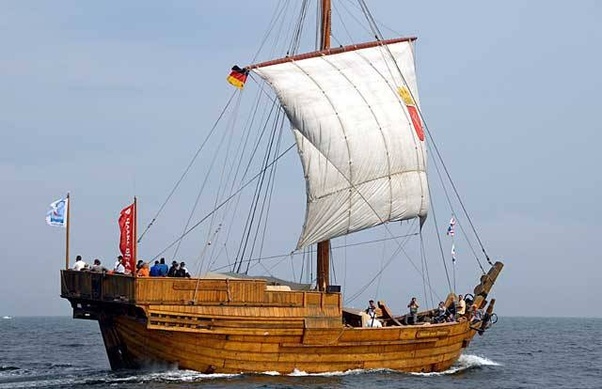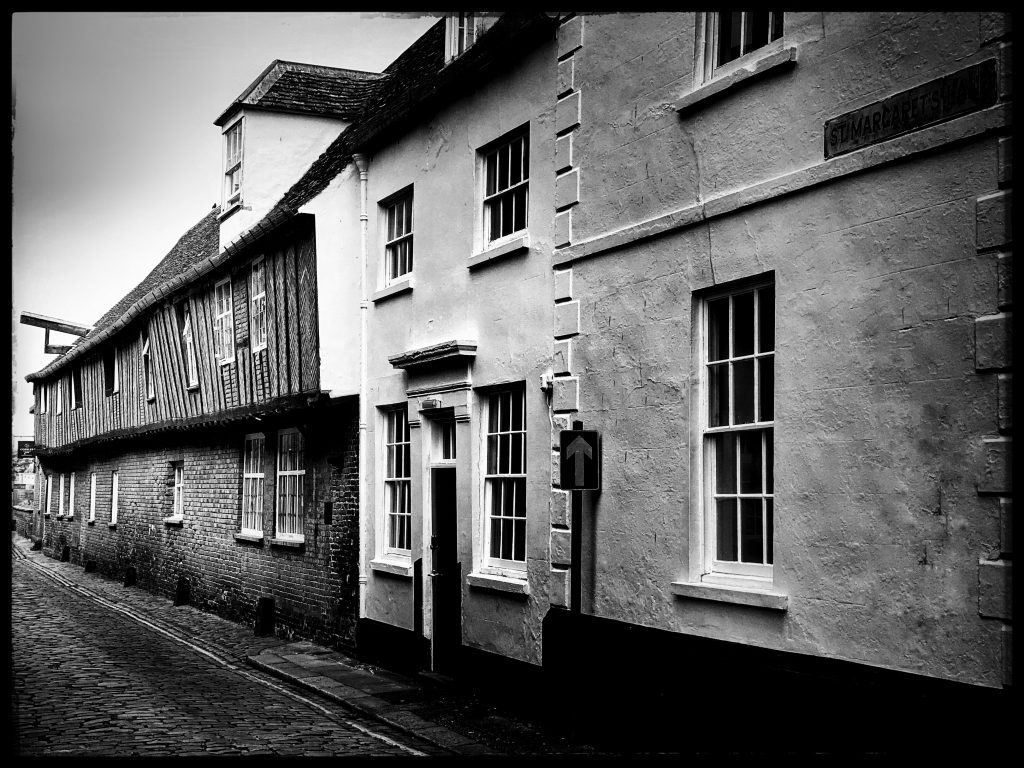Why did trade disputes miles away at sea end up leaving such a mark on a Norfolk Market Town?
The Bay Fleet Attacks
In the summer of 1449 Robert Winnington from Dartmouth, the commander of an English fleet patrolling the Channel, ordered his ships to harass and commandeer some other vessels. In one sense there was nothing unusual or wrong about this command. He had been tasked by Henry VI of England to keep the Channel free from pirates. Winnington could argue that he was just doing his job.
If you want to preserve meat and fish without refrigeration, especially oil-rich fish such as herring, you need plenty of salt. In the mid-fifteenth century the best place to get high quality, pure white salt, produced through evaporation, was from the Bay of Bourgneuf in southern Brittany. Every year in the summer merchants from Holland and Flanders and from the Hanseatic League ports along the Baltic coast would send their ships through the English Channel. These merchants would sail along the French coast to Bourgneuf to buy their essential Bay Salt. The annual shipping movement of the Bay Fleet was well known.
Unfortunately Robert Winnington started to harass these vessels. Perhaps the international tension about the Baltic cities’ desire to control the wool and cloth trade influenced his decision. Perhaps the pirate hunter had decided to engage in piracy himself. The lawlessness may have just have reflected the growing lawlessness in the kingdom due to the growing folly and negligence that was characterising Henry VI’s regime at this time. Whatever his motives, Winnington engaged in an unprovoked peace-time assault and captured sixty Hanseatic ships and fifty from the Low Countries and took them to the Isle of Wight.
Although the Bay Fleet ships were eventually released after diplomatic intervention, the Hanseatic League believed that the attack must have been sanctioned by the king. (Such actions by financially-strapped medieval monarchs would not have been unheard of at the time.) An eight-years armistice was finally agreed in 1456.
A further attack on the Hanseatic ships in 1458, when the Earl of Warwick seized the fleet’s cargo of salt, did little to improve relations. Warwick attempted to justify the piracy by claiming that he needed the money to pay the English garrison in Calais whose wages were, as ever, in arrears.
Peace talks at Hamburg failed in 1465, in particular since England denied any payment of compensation and the Hanseatic cities disagreed about what they wanted.

The attacks were very short-sighted moves and understandably started a period of reprisals. Ports such as London, Boston, and King’s Lynn had been trading with the continental ports for many years. However, as a result of the attacks, English goods (significantly wool) were now excluded from continental markets. This trading ban would have hurt both the merchant class who were used to selling their wool to cloth-making centres such as Ghent, Ypres, and Bruges, and also the peasants who produced about two-thirds of the raw material.
The Iceland Incident
An already tense situation was further exacerbated in 1468. Sailors from Lynn and Bristol attacked a Danish colony in Iceland (possibly over a fishing monopoly) and killed the governor and his family. As soon as he found out, the King of Denmark ordered the seizure of some English ships in the Baltic Sound as recompense. Significantly, for this to take place, the King of Denmark had to get help from vessels chartered from Hanseatic Danzig (modern day Gdańsk).
In England the owners of the captured English vessels ignored Denmark’s involvement (perhaps wilfully or in ignorance) and blamed the Hanseatic League. Six ships (which included two from Lynn) had been captured by Hanseatic members from Danzig. The owners petitioned the English king, Edward IV, who ordered the seizure of all Hanseatic goods and merchants. This seizure now united the whole of the Hanseatic League against England.
The Peace Settlement and Thank You Present
As the self-inflicted loss of revenue continued to hit home, and with Edward IV facing the crisis of the Wars of the Roses, England was keen to settle the dispute. Edward (a Yorkist) had briefly been deposed by the Earl of Warwick (a Lancastrian) in 1470 and driven into exile. He had left for Bruges from King’s Lynn (a Yorkist supporting port) in a hurry in October having to avoid capture by Hanseatic vessels.
His return to England (at Ravenspur) the following March was backed by wealthy continental merchants and by the Duke of Burgundy (Charles the Bold) who realised they had a lot to lose if Edward wasn’t on the throne. Edward wanted to reward their support. Ironincally, in order to return to England, Edward had to hire Hanseatic ships by promising commercial privileges (15 of his 36 ships were Hanseatic). Edward was also planning a war with France because of French support for Warwick. He wanted to thank the League, but also needed to ensure that any threat from the Hanse was neutralised. Peace was finally achieved in the Treaty of Utrecht (1474). England’s willingness to settle meant that the German delegation achieved most of its aims.
The Hanseatic League was given back its trading posts (steelyards) in London and Boston. And it insisted on being allowed a new one in Lynn.
Why did the Hanseatic League want a steelyard in Lynn? Well, members of the League had been trading with the town since the thirteenth century and they already appreciated its importance. In the 13th century, Lynn could still be ranked highly as an important port of England and was as important to England in medieval times as Liverpool was during the Industrial Revolution. In addition to the port it also had waterway and road links inland that facilitated trade to ten counties.

Photo © James Rye 2021
The English king gave the League a quay and tenements in Lynn (significantly inside the town wall, next to the Saturday Market Place, opposite St Margaret’s Church). The Hanseatic buildings are now part of the iconography of King’s Lynn. They are the only surviving Hanseatic business headquarters in England.
By 1500 there were around 40 German merchants operating in King’s Lynn.
Further Questions
But what was the Hanseatic League? And what happened to the Hanseatic Building in King’s Lynn after 1474?
What was the Hanseatic League?
What happened to the Hanseatic Buildings after 1474?
Book a Walk with a Trained and Qualified King’s Lynn Guide
© James Rye 2021
Sources
- Eddison, J. (2013) Medieval Pirates: Pirates, Raiders and Privateers 1204 – 1453, The History Press
- Friedland, K. & Richards, P. (eds) (2005) Essays in Hanseatic History: The King’s Lynn Symposium 1988, Larks Press
- Hillen, H.J. (1907) History of the Borough of King’s Lynn, Vol.1, EP Publishing Ltd
- Jacob, E.F. (1961) The Oxford History of England – The Fifteenth Century 1399-1485, Oxford
- Johnson, L. (2019) Shadow King: The Life and Death of Henry VI, Head of Zeus Ltd
- Jones, D. (2014) The Wars of the Roses: The Fall of the Plantagenets and the Rise of the Tudors, Penguin
- Kleineke, H. (Accessed June 2021) A Letter Relating To The Crisis of 1468, Published online at http://www.thericardian.online/downloads/Ricardian/20/06.pdf
- Pedersen, F. (2006) Trade and Politics in the Medieval Baltic: English Merchants and England’s Relations to the Hanseatic League 1370-1437, in Amelang J.S. & Beer, S. (eds) Public power in Europe: studies in historical transformations, Pisa University Press
- Pollard, A.J. (2016) Edward IV, Penguin
- Richards, P. (2022) King’s Lynn and the German Hanse 1250-1550, Poppyland Publishing
- Rose, S. (2018) The Wealth of England: The medieval wool trade and its political importance 1100-1600, Oxbow Books
- Santiuste, D. (2010) Edward IV and the War of the Roses, Pen & Sword
- Sutton, A.F. (2015) Lynn Episcopi, a Yorkist Port and Borough, With Particular Reference to the 1480s and the Reign of Richard III, The Ricardian, vol.25, no.5, pp.1-35
Websites all accessed June 2021:
- https://de.zxc.wiki/wiki/Stalhof
- https://www.britannica.com/topic/Hanseatic-League/The-League-at-its-outset
- https://www.visitwestnorfolk.com/places/kings-lynn/history-of-kings-lynn/hanseatic-kings-lynn/
- https://en.wikipedia.org/wiki/Hanseatic_League
- https://www.ancient-origins.net/ancient-places-europe/hanseatic-league-0013886
- https://en.google-info.org/14076996/1/anglo-hanseatic-war.html

Really interesting, thank you.
Those in charge of rejuvenating the town and surrounding area would do well to look in the rear view mirror and use information such as this account of history to infuse new vigor here.
Thanks for your comment.
I may be wrong, but I feel reasonably sure that at least some of the Council team are working to promote the history of the town. For example, I know that the Lynn Town Guides offer regular historical walks and actively recruit to keep the team of volunteers refreshed.
[…] was to enable combined action against pirates and land robbers (see this in action – Hanseatic League and King’s Lynn 1 of 3). Effort was also put into the provision of lighthouses, marker buoys, trained pilots, and other […]
[…] permission was granted to build on the site (see Hanseatic League and King’s Lynn (1 of 3)), two hanseatic warehouses were built around 1480, together with a street range facing the market […]
[…] this return had on King’s Lynn can be seen in the building of the Hanseatic Warehouse (see HERE for more […]
[…] In 1473-74 Thomas’s status in the town can be seen from the fact that he was one of the four town merchants designated to act as intermediaries in the discussions relating to King’s Lynn in the negotiations at the end of the Wars of the Roses. Edward IV was negotiating peace with the Hanse (leading to the Treaty of Utrecht in 1474). For the first time the Hanse were to be allowed to build a steelyard in Lynn. (See Hanseatic League and King’s Lynn 1.) […]
[…] The Hanseatic League in King’s Lynn 1 […]
[…] See also: Hanseatic League and King’s Lynn 1 of 3 […]
[…] Original Article […]
[…] and after the Treaty of Utrecht in 1474, amongst other things, the Hanseatic League were able to open a steelyard inside the town walls of […]